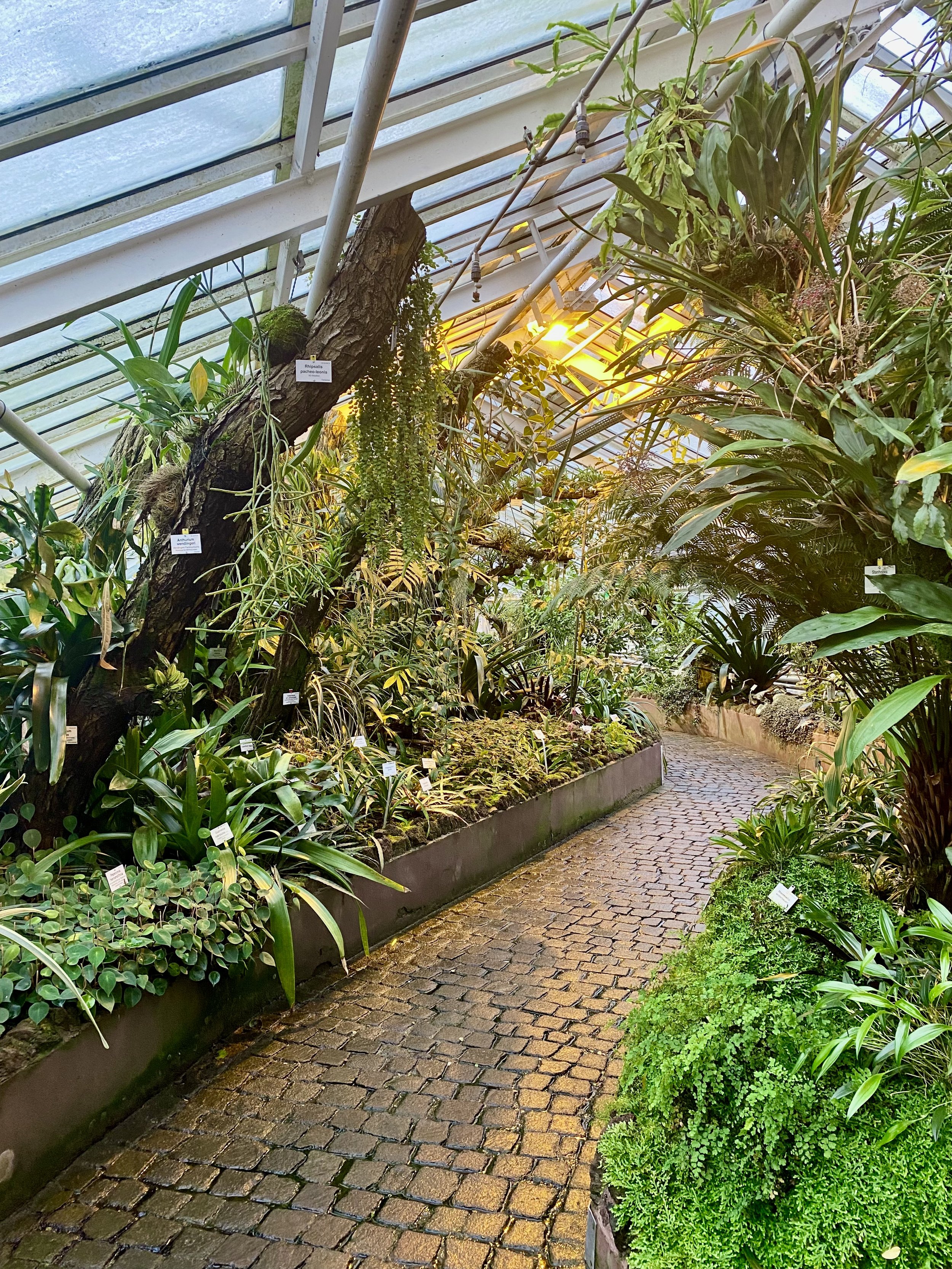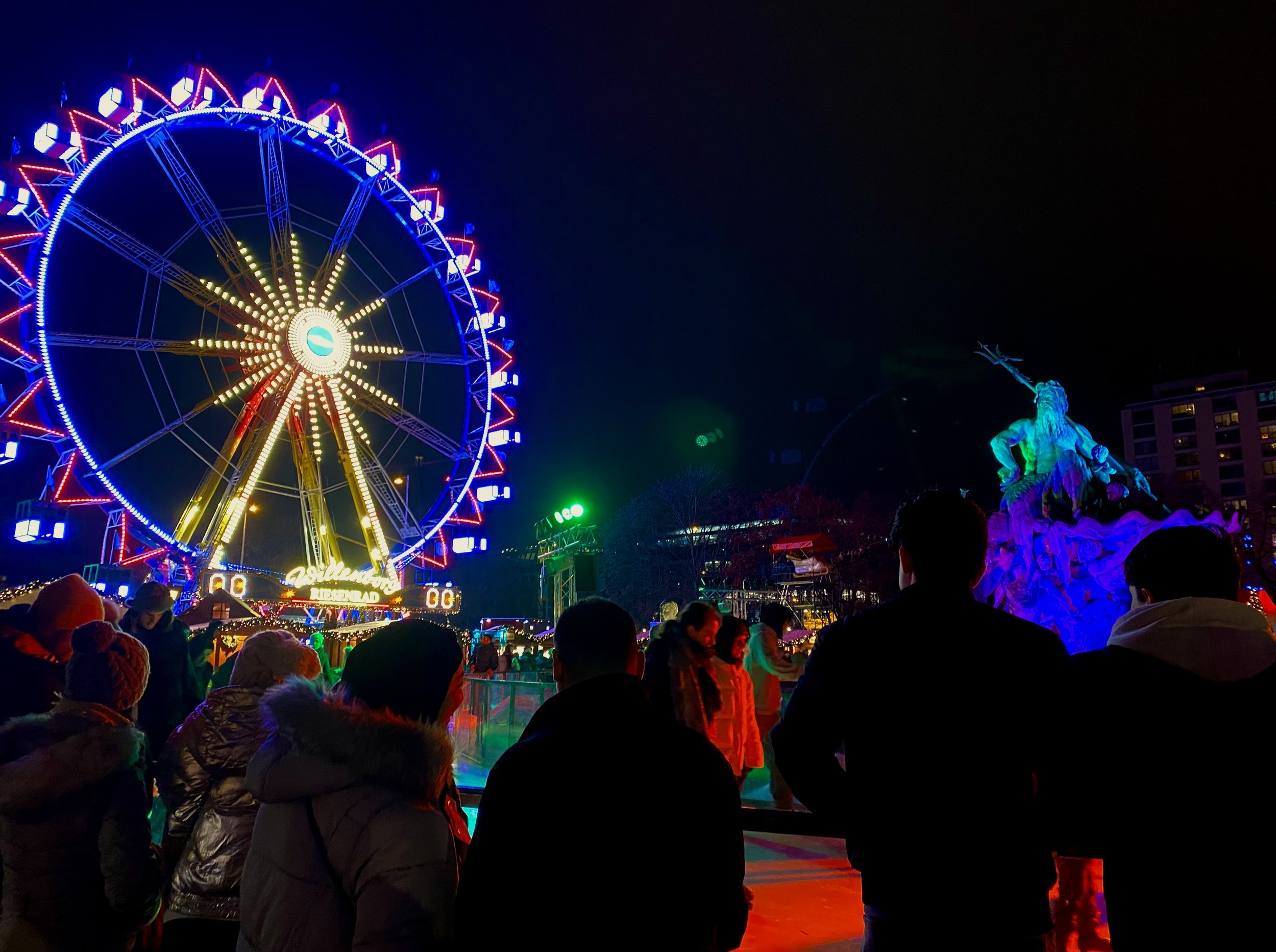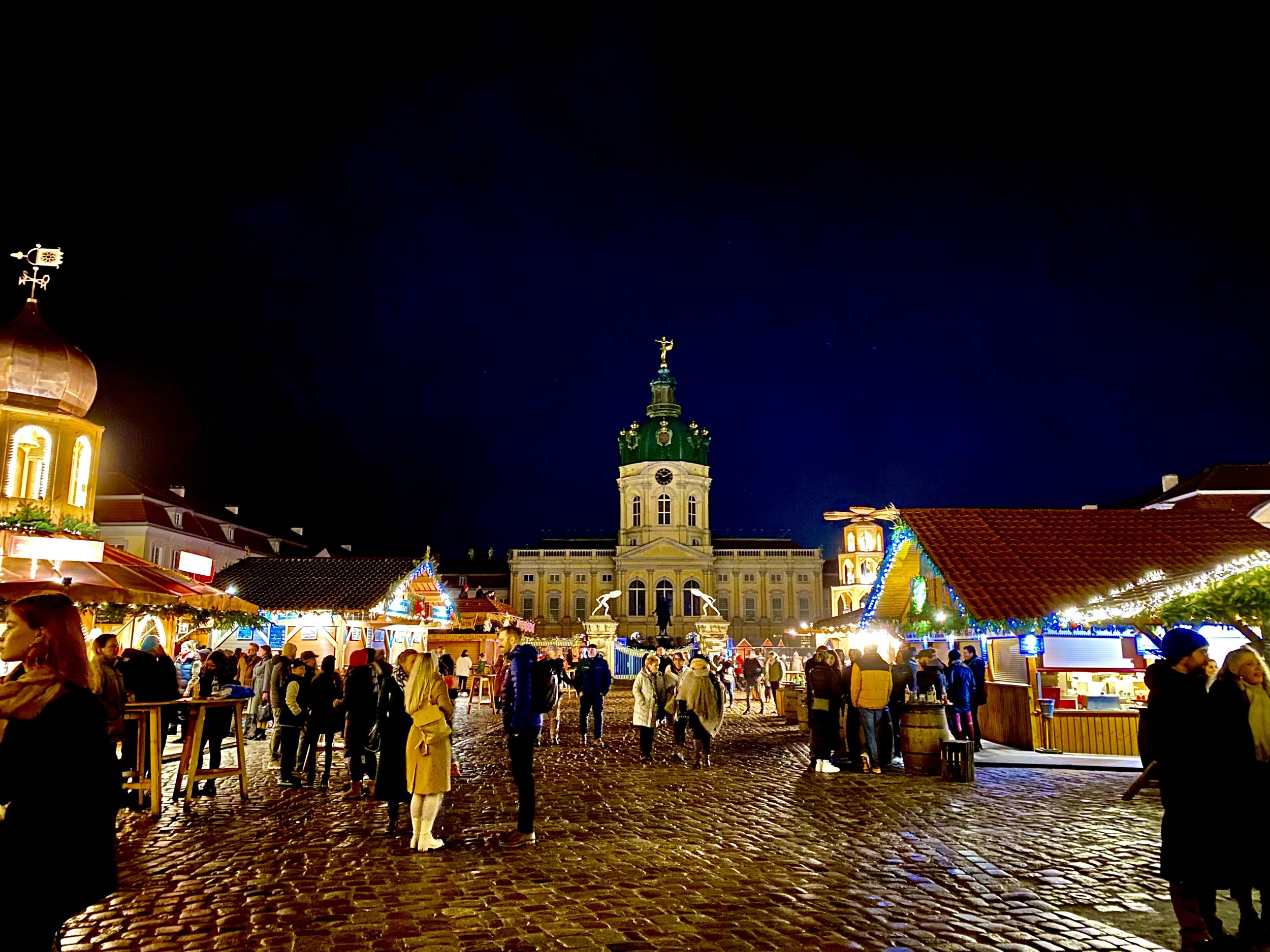December 30, 2022: Christmas Magic in Berlin
Charlottenburg Palace lit up for the Christmas Market
Greetings from 35,000 feet (more or less)! We’re currently on our way back to Montenegro on an itty-bitty Luxair plane. It’s a squeeze, but they serve meals (we even got sandwiches on our 90 minute flight from Berlin) and the drinks seem to be a free for all. I got coffee and orange juice with breakfast, and the lady sitting next to me had wine (for free) as well as water with her sandwich on the flight we took the other night. I feel like it says something about the air travel industry that I’m baffled by a company providing food and beverage to its economy passengers on short flights.
Anyway, let’s wrap up 2022 so we can usher 2023 in on a clean slate.
We landed in Berlin on the 17th to frigid weather. It was below freezing and humid (humidity always makes it worse, whether it’s hot or cold). The Berlin-Brandenburg Airport is new since my last visit. During my exchange year it was a popular dinner topic, with the adults often complaining of the ever-more-expensive project and joking that it would still be under construction when they died. It reminded me of the I-580 construction through Washoe Valley, which was a fixture of my childhood. Attempts to construct the big bridge over a windy canyon turned into a saga that spanned a decade, and I grew up listening to complaints about the “impossible” project.
Nevertheless, the airport, like the bridge, is now complete, and replaces Shonefeld and Tegel, the latter which I was deeply familiar with (towards the end of my exchange year I visited it a dozen or more times to see off other exchange students), and it’s the airport I always flew in and out of. I’ve been to the new airport only once, upon my arrival in June, and my cousin quickly whisked me off that time. So I’m not familiar with the layout of this airport, and I’d never had to get to or from it with public transportation before. Still, I know Berlin’s transportation system well enough that I thought I could figure it out.
We wasted a solid half an hour while I messed around with the ticket machines and tried to decipher the signs. This airport is massive. It’s also modern and has all the fanciest gadgets, and supposedly the S9 comes straight to the terminal. Now, whether it actually does or not, I couldn’t tell you. We ended up taking the bus.
On the first full day we visited the Jewish Museum. This museum is definitely one you should put at the top of the list if you’re ever in Berlin. I still remember the first time I visited it. The design of the building is part of the experience, meant to disorient you, isolate you, make you feel small or cold. It’s filled with interesting artifacts and more information than you could process in a lifetime. Incredibly, it’s also free. The experience is hugely impactful, but not as challenging as visiting a concentration camp. The Germans don’t pull punches when it comes to remembering the past. They want to remember the worst of it, want you to understand just how bad it was, so it doesn’t become just another passage in a history book that we forget. The lessons are brutal, but necessary. The Jewish Museum of Berlin does an excellent job of elucidating the worst parts of that history without making it overwhelming.
The other museum we went to was the Pergamon, which is unique because it reconstructs monuments and buildings from archeological sites around the world using a combination of artifacts and reconstructions. It can be very cool, because when you can walk through the Ishtar Gate without setting foot in Babylon, and emerge on the other side in ancient Rome, it feels completely surreal. Unfortunately, they’re doing a massive overhaul of the museum right now, moving and restoring many of the exhibits, so there was a lot we didn’t get to see.
A bust overlooks a re-created Roman courtyard in the Pergamon Museum
We visited the botanical garden, despite the poor weather. Berlin’s botanical garden is worth the 6 euro ticket in all seasons, because even in the winter, the massive complex of greenhouses are rife with hundreds of stunning plants and flowers. It’s a great way to escape the frigid weather while still getting all the benefits of nature.
Inside one of the greenhouses. December in Berlin, everyone!
I dragged Nicole to Kaufhaus des Westens, affectionately known as KaDeWe, because it’s about as close to Christmas at Macy’s as you can get in Berlin and because I was hoping to see Nicole’s jaw drop like mine did the first time I set foot inside. She was initially rather underwhelmed. Despite my attempts to point out how unbelievably massive the place is (eight floors occupying an entire city block) it didn’t really sink in under I was quibbling over which chocolate boxes to buy for my relatives and Nicole, growing bored with my indecisiveness, said she was going to go look in the hobby section we spotted on our way in.
We actually did a lot of shopping in Berlin. Well, mostly window shopping. I think it just felt great to be back in a big city with actual malls and brands we recognized with high-quality products (which, as Nicole can attest to after a pair of boots she bought in Albania basically disintegrated around her feet in less than two weeks, can be difficult to find in a lot of the places we’ve been the last six months). We went to Alexa, the big mall in Alexanderplatz that I frequented during my exchange year, and the Mall of Berlin near Potsdamer Platz (which has a Desigual, one of my favorite stores).
An hour later, after circling the 4th and 5th floors a dozen times, we finally found each other again, and I got to see the expression of complete disbelief I’d missed when we first entered. Apparently me saying, “seriously, this place is possibly the largest store I’ve ever been in, it’s like a city in and of itself,” only warrants a non-committal affirmative hum, but getting totally and utterly lost for an hour drives the point home.
We did a lot of walking around Berlin just to see the sights. The Brandenburger Tor, Fernsehturm, Checkpoint Charlie, Gedenknis Kirche, and so on. Berlin is a great city to just wander. There’s always something to see around the corner, and there’s always an U- or S-Bahn station nearby in case you get lost.
And, of course, we visited the Christmas Markets.
Weihnachtsmarkte are one of the best things about celebrating the holidays in Berlin. The whole community turns out, and each market has a unique vibe. The Christmas Market is not a uniquely German tradition, and historians say it’s a more recent practice than we might think. Though medieval December markets are documented, they weren’t related to the holiday season. Rather, they were merely a way to bolster the local economy and increase trade during the slower months.
Giant Candle Spinner in Alexanderplatz
Still, when I think of Christmas, Berlin’s Christmas markets are the first thing to come to mind. From the sleek white tents and elaborate light show at Charlottenburg Palace (which, unfortunately, is slated to be gone for good after 2022) to the raucous, colorful cabins and massive model candle spinner of Alexanderplatz, there’s nothing better. Despite the cold, I can’t help but feel warm in the hustle and bustle of the markets, surrounded by light and color and fantastic smells.
Lebkuchen is not gingerbread. At least not the way we think of it in the States. It shares some of the flavors, certainly, but it’s softer and comes in many shapes and forms, and it’s made with ground nuts and citrus peel. It’s a Christmas market staple, often sold in the shape of a heart and prettily decorated with colorful frosting. These cookies come small, but they can also be massive. I’ve seen them two feet wide.
Gebrannte Mandeln are, literally translated, roasted almonds, but that doesn’t begin to explain them. They’re coasted in butter and sugar and often a flavoring of some kind, and served still warm. Stalls will cook up dozens of flavors, from chocolate to strawberry to coconut rum. My favorite, though, are the classics. These little beauties are so good they don’t need anything else, and the smells wafting out from the sizzling pans are to die for.
Glühwein is, in my opinion, done best in Germany. I know you know the Germans for their beer, but trust me, no one knows better how to whip up a drink to help you warm up on a cold night. Well, perhaps the Nordic countries, I suppose, but I’ve never been up there and can’t speak to that.
And then there’s the actual food. You know, what you’re supposed to eat for dinner (though I can totally fill up on gebrannte mandeln). Berlin has become a very international city, and that’s reflected in the offerings here. You can find freshly made curry, burgers, and kebabs alongside schnitzel and goulash. But no matter what they’re cooking, it’s the rich smells of winter herbs and heavy, cold-weather sauces that drift through the winding paths of the market. It’s utterly mouth-watering.
Ferris wheel and ice rink around the statue of Neptune at St. Marienkirche Weihnachtsmarkt
But if the food and booze isn’t enough to convince you, let’s talk about the music. Carolers, sure, but also bands, sometimes small orchestras or other performers. Some markets wire speakers throughout and play a wide range of holiday music. At St. Marienkirsche, there’s an ice rink built around a statue of Neptune and lit in neon colors. Most markets have some sort of Ferris wheel. Lots of them have rides for children, or at least games to play, and I recall a small petting zoo once.
There are always scarves and hats and other winter clothes for sale, but the classic German crafts are, I think, of more interest. Handmade candles, intricately sculpted or carved. Wooden figurines or dishes, and the enchanting wooden candle spinners, which use the rising heat to make a scene come to life. And my favorite: Weihnachtssterne. Christmas stars. Made from paper, they come in an array of colors, designs, and sizes. Their designs sometimes evoke the winter wonderland around you, or remind us of spring and warmer days ahead. They light up the night and look absolutely magical.
We hit five Christmas Markets during our time in Berlin, including the one at Charlottenburg Schloss, which I was incredibly grateful for since 2022 was supposed to be its last year (there was a petition to keep it, so I’m holding out hope) and it’s my favorite. There’s something so magical about the white tents and the colorful light display playing over the castle. Though we had a really special experience at the Gedächtnis Kirche this year, too. We happened to arrive right as they were having a memorial for the attack on December 19, 2016, when a truck deliberately drove into the Christmas market there and killed 12 people, injuring 50. All the lights were off, making the entire plaza completely dark. At first we thought it was closed, but saw people wandering about and went to check it out. As the memorial ended, the lights slowly, one by one, started flicking back on. The market came to life before our eyes, a true symbol of how no act of violence, despite the darkness of the moment and the loss it incurs, can ever extinguish the light. How we, particularly in the holiday season, come together to bring color and light and joy to the long nights.
Charlottenburg Schloss Weihnachtsmarkt. We signed a petition to keep it going, as 2022 is supposed to be the last year for it.






